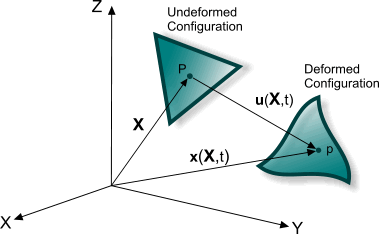Displacement
Applied loads can result in a displacement of the solid structure from an initial configuration to a deformed configuration. The total displacement is a combination of rigid body motion and the relative displacements of the points in the body, which determine the deformation of the solid structure.

If the position of a material point in the undeformed configuration is , and the displacement of this point to the deformed configuration is , the position of the material point in the deformed configuration is:
In component form, the displacement can be expressed as:
The displacement field of a rigid body is completely defined by a single displacement vector. The displacement field of a deformable body is defined by the set of displacement vectors of its material points.
Deformation Gradient
The deformation gradient tensor measures how the deformation changes from point to point:
where is the identity matrix and , , and are the Cartesian components of the material point position vector .
For incompressible and nearly incompressible materials, the deformation gradient can be decomposed into a volumetric part and a deviatoric part :
with: